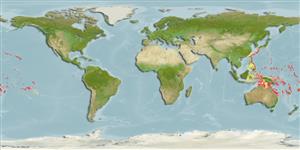Common names from other countries
Environment: milieu / climate zone / depth range / distribution range
Ecologia
marinhas associadas(os) a recifes; intervalo de profundidade 0 - 40 m (Ref. 89972). Tropical; 30°N - 30°S
Pacific Ocean: Ryukyu Islands to the Great Barrier Reef and the Hawaiian, Marquesan and Ducie islands.
Tamanho / Peso / Idade
Maturity: Lm ? range ? - ? cm
Max length : 18.0 cm TL macho/indeterminado; (Ref. 48636)
Espinhos dorsais (total): 12 - 13; Raios dorsais moles (total): 26-29; Espinhos anais 3; Raios anais moles: 20 - 22.
Relatively common on exposed seaward reefs; occasionally on shallow lagoon reefs in areas of rich coral growth and clear water. Juveniles in protected coral areas (Ref. 48636). Benthopelagic (Ref. 58302). In pairs in Indonesia but schools in some Pacific locations (Ref. 48636). Often in pairs during breeding and feed mainly on scleractinian coral polyps. Easily approached (Ref. 9710). Oviparous (Ref. 205), monogamous (Ref. 52884). Minimum depth reported taken from Ref. 128797.
Life cycle and mating behavior
Maturidade | Reprodução | Desova | Ovos | Fecundidade | Larvas
Distinct pairing (Ref. 205). Monogamous mating is observed as both obligate and social (Ref. 52884).
Myers, R.F., 1991. Micronesian reef fishes. Second Ed. Coral Graphics, Barrigada, Guam. 298 p. (Ref. 1602)
Categoria na Lista Vermelha da IUCN (Ref. 130435)
CITES (Ref. 128078)
Not Evaluated
Ameaça para o homem
Harmless
Utilização humana
Pescarias: pouco comercial; Aquário: Espécies comerciais
Mais informação
ReferênciasAquaculturaPerfil para aquaculturaEstirpesGenéticaElectrophoresesHereditariedadeDoençasProcessamentoMass conversion
Ferramentas
Relatórios especiais
Descarregue XML
Fontes da internet
Estimates based on models
Preferred temperature (Ref.
115969): 24.6 - 29.3, mean 28.1 (based on 1338 cells).
Phylogenetic diversity index (Ref.
82804): PD
50 = 0.5000 [Uniqueness, from 0.5 = low to 2.0 = high].
Bayesian length-weight: a=0.02291 (0.01133 - 0.04632), b=3.00 (2.83 - 3.17), in cm Total Length, based on LWR estimates for this Genus-body shape (Ref.
93245).
Nível Trófico (Ref.
69278): 2.6 ±0.40 se; based on food items.
Resiliência (Ref.
120179): Elevada, tempo mínimo de duplicação da população menor que 15 meses (Preliminary K or Fecundity.).
Fishing Vulnerability (Ref.
59153): Low vulnerability (10 of 100).
